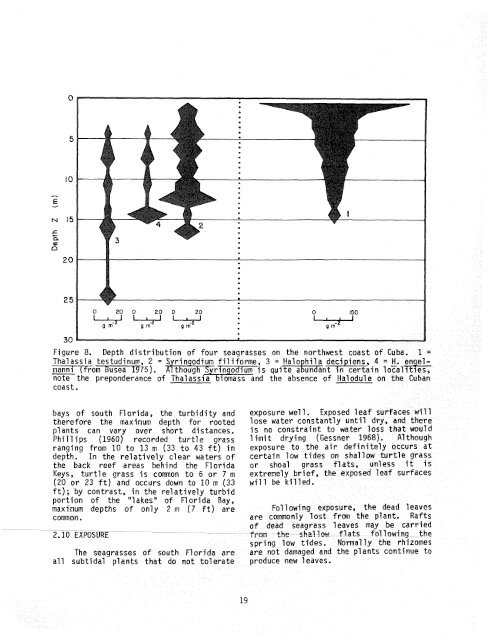The Ecology of the Seagrasses of South Florida - USGS National ...
The Ecology of the Seagrasses of South Florida - USGS National ...
The Ecology of the Seagrasses of South Florida - USGS National ...
You also want an ePaper? Increase the reach of your titles
YUMPU automatically turns print PDFs into web optimized ePapers that Google loves.
0<br />
5<br />
10<br />
E<br />
d<br />
N 15<br />
f a<br />
a<br />
0<br />
20<br />
25<br />
30<br />
Figure 8. Depth distribution <strong>of</strong> four seagrasses on <strong>the</strong> northwest coast <strong>of</strong> Cuba, I =<br />
Thalassia testudinum, 2 = S rin odium filiforme, 3 = Halo hila decipiens, 4 = H. :nye1-<br />
m o m Susea 1g75). *r7nqodium is yi&nt in certain IoFal~t~es,<br />
note <strong>the</strong> preponderance <strong>of</strong> Thalassia biomass and <strong>the</strong> absence <strong>of</strong> Halodule on <strong>the</strong> Cuban<br />
coast.<br />
bays <strong>of</strong> south <strong>Florida</strong>, <strong>the</strong> turbidity and exposure well. Exposed leaf surfaces will<br />
<strong>the</strong>refore <strong>the</strong> maximum depth for rooted lose water constantly until dry, and <strong>the</strong>re<br />
plants can vary over short distances. is no constraint to water loss that would<br />
Phi 11 ips (1960) recorded turtle grass 1 imi t drying (Gessner 1968). A1 though<br />
ranging from 10 to 13 m (33 to 43 ft) in exposure to <strong>the</strong> air definitely occurs at<br />
depth. In <strong>the</strong> relatively clear waters <strong>of</strong> certain low tides on shallow turtle grass<br />
<strong>the</strong> back reef areas behind <strong>the</strong> <strong>Florida</strong> or shoal grass flats, unless it is<br />
Keys, turtle grass is common to 6 or 7 m extremely brief, <strong>the</strong> exposed leaf surfaces<br />
(20 or 23 ft) and occurs down to 10 rn (33 will be killed.<br />
ft); by contrast, in <strong>the</strong> relatively turbid<br />
portion <strong>of</strong> <strong>the</strong> "lakes" <strong>of</strong> <strong>Florida</strong> Bay,<br />
maximum depths <strong>of</strong> only 2 m (7 ft) are Fol lowing exposure, <strong>the</strong> dead leaves<br />
common. are commonly lost from <strong>the</strong> plant. Rafts<br />
<strong>of</strong> dead seagrass leaves may be carried<br />
2.10 EXPOSURE frm <strong>the</strong> shallow flats following <strong>the</strong><br />
spring low tides. Normally <strong>the</strong> rhizomes<br />
<strong>The</strong> seagrasses <strong>of</strong> south <strong>Florida</strong> are are not damaged and <strong>the</strong> plants continue to<br />
all subtidal plants that do not tolerate produce new leaves.<br />
19

















